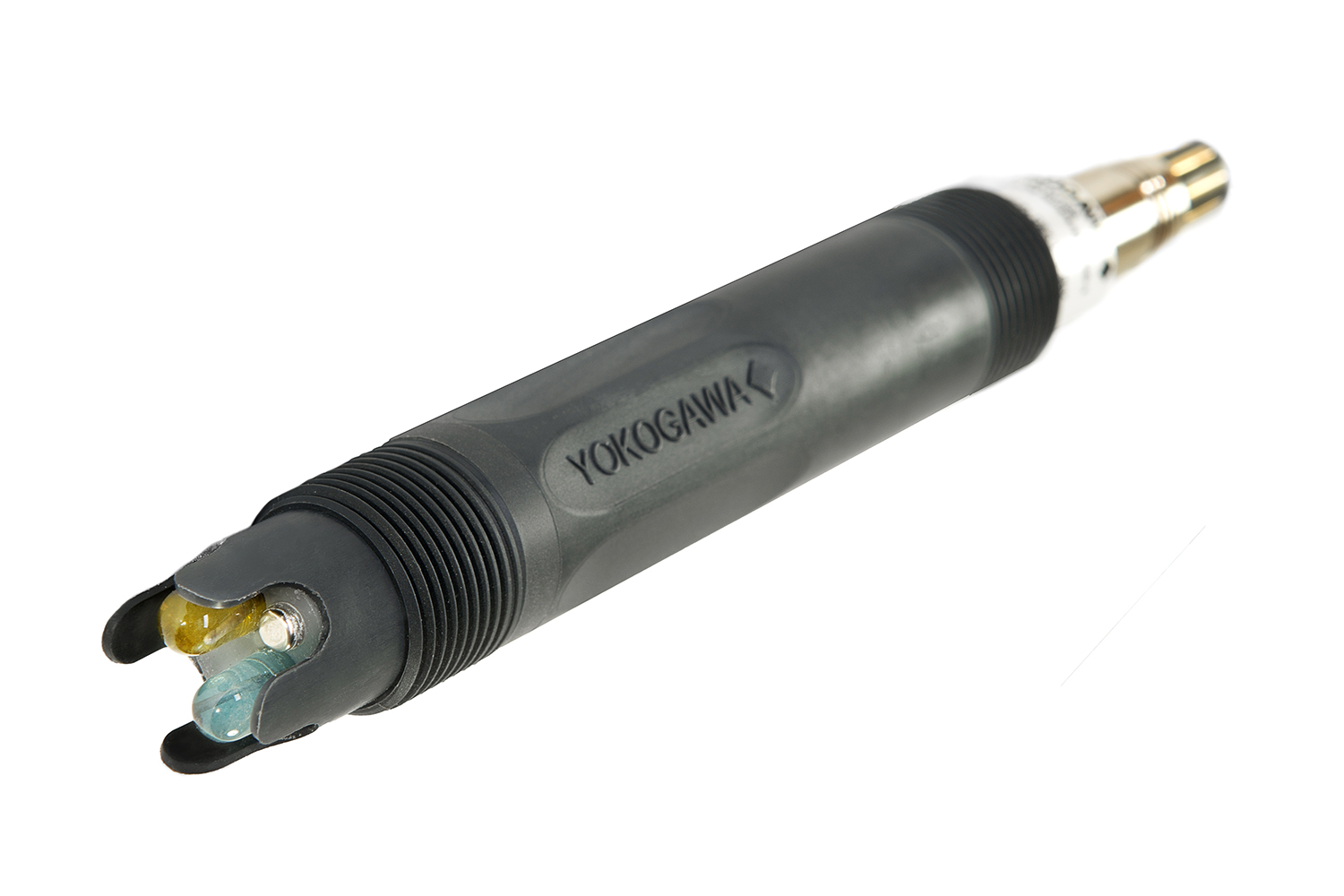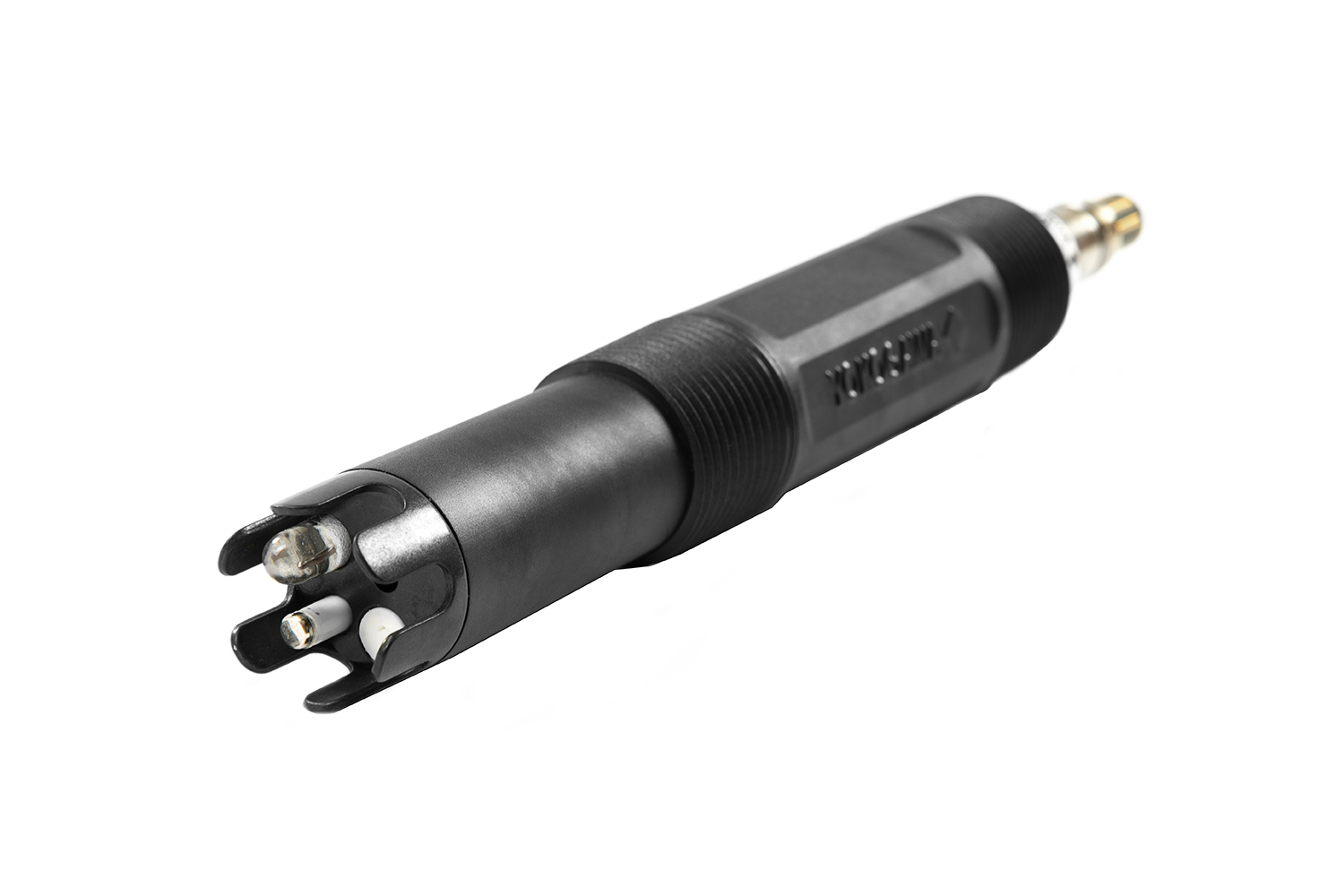Die Universalsensoren FU20 und FU24 zeigen, wie Yokogawa das Motto „einfach ist am besten“ auf Sensortechnologie anwendet. Diese Sensoren verfügen über vier separate Elemente (pH- und Redoxelektrode, Referenzelektrode, Temperatursensor), was die gleichzeitige Messung von pH und ORP (Redox) mit einem einzigen Sensor in einem robusten Gehäuse aus Ryton oder PVDF (FU20) und Ryton (FU24). Das integrierte oder Variopin-Kabel mit Nummerncode macht zusammen mit den integrierten NPT-Gewinden am Sensor die Installation sehr einfach. Die Schnellwechseladapter für den FU20 ermöglichen eine schnelle Entnahme des Sensors zur Reinigung und Kalibrierung.
Welcher Sensor ist der Richtige für Sie?
Es gibt nun SECHS unterschiedlich Großraumsensorausführungen zur Auswahl.
Verwenden Sie bitte die Diagramme unten als Anleitung zur korrekten Auswahl der am besten für Ihre Anwendung geeigneten Version.

Details
- Verfügbar als analoge Sensoren und digitale SMART-Sensoren (SENCOM)
- Massive Platin-ORP/LE-Elektrode für genaue und gleichzeitige pH- und ORP-Messungen.
- Integrierter Pt1000-Temperatursensor für präzise Temperaturmessungen und größere pH-Genauigkeit
- Doppeldiaphragma und langer Diffusionspfad zur Vermeidung von Kontamination/Vergiftung der Referenzelektrode
- Das gesättigte Ag/AgCl-Referenzsystem mit Doppeldiaphragma verlängert in Kombination mit polymerisiertem gesättigtem KCl und Ionenfalle die Lebensdauer der Referenzelektrode auch in chemisch problematischen Umgebungen.
- Erhöhte Lebensdauer durch ein großes Volumen polymerisierten Elektrolyts und poröses PTFE-Diaphragma
- Kationdifferenz-Referenzsystem für eine längere Lebensdauer für den FU20 erhältlich
- Variopin-Anschluss oder integrierte Kabeloptionen
- Einfache Wartung durch einen übersichtlichen Aufbau
- Vielseitige direkte Inline-, Eintauch- oder Offline-Installation (Durchflussarmatur) und auswechselbarer Hochtemperaturteil (nur für Verwendung mit dem FU20 verfügbar)
- Schnellwechseladapter für den FU20 lieferbar
- Ein Kalibrierzertifikat liegt jedem Sensor bei
- Patentierter automatischer Druckausgleich im FU24
- Lieferbar in zwei Versionen, einem Modell mit robuster kuppelförmiger Elektrode für Medien mit geringem Feststoffgehalt und einem Modell mit flacher Elektrode für Anwendungen mit erheblichem Feststoffanteil
Der Kombisensor FU20 zeigt, wie Yokogawa das Motto „einfach ist am besten“ auf Sensortechnologie anwendet. Die Großraumsensoren (26 mm Durchmesser) enthalten vier separate Elemente in einem unzerbrechlichen PPS40GF (RytonTM)- oder PVDF-Gehäuse. Die Installation gestaltet sich mit dem integrierten industriellen 3/4“-Kegelgewinde sehr einfach. Das große Volumen an geliertem Elektrolyt und das Doppeldiaphragma-Referenzsystem verlangsamen den Elektrolytverbrauch und die Vergiftung des Referenzsystems und verlängern so dessen Lebensdauer. Das System ist auf solche Anwendungen zugeschnitten, bei denen sich Einfachheit in genauen und zuverlässigen pH- oder Redoxmessungen niederschlägt. Dies bedeutet, dass dieser Sensor in 90 % der Fälle eine hervorragende Wahl darstellt.
Der FU24 ist ein pH- und ORP-Universalsensor mit chemisch beständigem PPS 40GF-Gehäuse für anspruchsvolle pH-Messanwendungen. Er ist besonders nützlich in Anwendungen mit Fluktuationen von Druck und/oder Temperatur. Diese Prozessbedingungen verkürzen die Sensorlebensdauer, weil die Prozessflüssigkeiten durch häufige Druck- und/oder Temperaturschwankungen in den Sensor hinein- und wieder herausströmen. Dies führt zu einer schnellen Entsalzung und Verdünnung des Referenzelektrolyten, was seinerseits eine Änderung der Referenzspannung und somit Abweichungen bei der pH-Messung zur Folge hat.
Durch Integration des erfolgreichen und von Yokogawa patentierten Balgkonzepts in die FU24-Elektrode wird eine wirkungsvolle Druckkompensation erreicht. Der in die Elektrode integrierte Faltenbalg sorgt für einen sofortigen Ausgleich zwischen Innen- und Außendruck und macht den Sensor praktisch unempfindlich gegenüber externen Druckschwankungen. Ein leichter, von der Balgspannung verursachter Überdruck verhindert das Eindringen von Flüssigkeit und sorgt für einen Ionenfluss aus dem Sensor.
Publikationen
Wet scrubbers are used in utilities, paper mills, and chemical plants to remove sulfur dioxide (SO2) and other pollutants from gas streams. Undesirable pollutants are removed by contacting the gases with an aqueous solution or slurry containing a sorbent. The most common sorbents are lime, Ca(OH)2, and limestone, CaCO3.
Brewery is facility to produce beer. Breweries process is the manufacturing process of beer, which is a fermented beverage with low alcohol content made from various types of grain. Wheat, maize and other grains can be used for this. Brewing process starts from malted barley that is to form a mash by milling and mixing with hot water. The malt starches are converted to sugars during this process. This sugar rich water is then strained through the bottom of the mash and will be called as "wort". Then the wort will be brought to boil by bringing to the brew kettle. For bitterness or aroma hops are to be added at different times during the boil. Then the wort is cooled and aerated. And brewers yeast is added for fermentation. From the sweet wort the yeast produces carbon dioxide, alcohol and other byproducts. The GREEN BEER undergoes maturation after fermentation. Filtaration and carbonation are the last steps. Finally the beer will be stay in holding tank until it is bottled or kegged.
Caustic soda and hydrochloric acid, produced in electrolyzer plants, are fundamental materials used in varieties of industries; chemicals, pharmaceuticals, petrol-chemicals, pulp and papers, etc. Profit is the result of the effective production with minimized running / maintenance cost. Proper control of the process brings you stabilized quality of products with the vast operational profit.
For control of batch neutralization, a pH measurement coupled with a timer-controlled chemical feed scheme provides very satisfactory results.
This system can be adapted for either acid waste or alkaline waste neutralization.
Having too much oxygen in the process is not a problem for the biological system; however the cost for generating the oxygen is one of the largest expenses. By obtaining a good representative average of the dissolved oxygen present in the basin could save the plant large amounts of money. For this reason multiple measurements points are sometimes put into place.
There are a number of suppliers of oil and fat products used for edible purposes. These products include, but are not limited to olive oil, peanut oil, soybean oil, sunflower oil, lard, shortening, butter, and margarine. The raw materials for these products include animal by-products, fleshy fruits (palm and olive), and oilseeds.
Industry:Food and Beverage
After extraction from sugar cane or sugar beets, juice must be purified to remove the many other organics and minerals that accompany it. The processing to accomplish this is heavily dependent on reliable pH measurement and control as illustrated.
Process liquid analyzers such as pH meters, conductivity meters, ORP meters, and density meters play an important role at electrolysis plants in the control of concentrations of various process solutions. This requires both precision and stability under harsh conditions that include highly corrosive substances, high temperatures, and many impurities.
Cyanide-bearing wastewater from mining and electroplating facilities and certain types of chemical plants is toxic and must be treated by oxidation with chlorine or chloride to bring the cyanide concentration within regulatory limits.
Industry:Electrical and Electronics
Wastewater from electroplating facilities and certain types of chemical plants contains toxic forms of hexavalent chromium such as chromate and dichromate. The hexavalent chromium in this wastewater must be reduced before the water can be discharged. This requires a two-step process: hexavalent chromium (CR6) is reduced to trivalent chromium (CR3); and CR3 is precipitated as chromium hydroxide.
Industry:Electrical and Electronics
Removal of free oil and grease from a wastewater stream reduces the potential for equipment problems to occur further downstream. There are three forms of oil encountered in wastewater treatment at a refinery.
Power plant boiler houses designed to burn coal or high sulfur oil are required by Federal and State pollution regulations to "scrub" (remove) sulfur dioxide from flue gasses to meet emission limits. SO2 in flue gasses is known to be harmful to the environment, as it is one contributor to the formation of acid rain. pH control is critical for the proper functioning of the scrubber system.
The treatment of wastewater from pulp and paper plants is a serious environmental concern. Yokogawa's submersion holder with an ultrasonic+air-jet cleaner (customized product) can reduce the manual cleaning frequency to just once every one or two months.
Industry:Pulp & Paper
Fish perform all their bodily functions in water. Because fish are totally dependent upon water to breathe, feed and grow, excrete wastes, maintain a salt balance, and reproduce, understanding the physical and chemical qualities of water is critical to successful aquaculture. To a great extent water determines the success or failure of an aquaculture operation.
Current trend for increasing mercury awareness throughout the public sector has caused the government to take action. Recently, the Environmental Protection Agency (EPA) has focused their efforts on controlling mercury levels produced in various coal fired power plants. Based on information from several case studies, the EPA developed the Mercury and Air Toxics Standards to cut back mercury emissions. The most popular technology utilized by coal plants to meet the new standards is a scrubber which cleans the off gas from the combustion process. ORP sensors can further monitor the effluent from these scrubbers to ensure optimal mercury emission levels are achieved. By closely monitoring the mercury concentrations in the effluent, plant managers will be able to easily confirm their plants are meeting the EPA's standards.
Downloads
Bedienungsanleitungen
Datenblätter
Zertifikate
- EU_UK Declaration of Conformity FU20 2022-11-14 (170 KB)
- EU_UK Declaration of Conformity QT11 2022-11-14 (103 KB)
- EU_UK Declaration of Conformity QT11 2022-11-14 (103 KB)
- KCs_FU20(21-KA4BO-0418X) (157 KB)
- KCs_FU20 21-KA4BO-0416X) (147 KB)
- EC Type Examination FU20, FU24, pH20, SC24V and SC25V (2.1 MB)
- KCs_FU20(21-KA4BO-0417X) (155 KB)
- KCs_FU24(21-KA4BO-0415X) (156 KB)
- DEKRA 11ATEX0014X-Iss2-E FU20, FU24, SC24V and SC25V (308 KB)
- KCs_FU24(21-KA4BO-0413X) (155 KB)
- FM20CA0062X FU20, FU24, SC25V, SC4A, SC42, SX42 (390 KB)
- KCs_FU24(21-KA4BO-0414X) (155 KB)
- EU_UK Declaration of Conformity FU24 2022-11-14 (149 KB)
- IECEx_DEK_11_0064X_Iss1 FU20, FU24, SC24V and SC25V (868 KB)
- TS_FU20/FU24/SC25V (1.8 MB)
- EACEx_FU20/FU24/SC25V (3.7 MB)
- Ex NEPSI_FU20/FU24/SC25V (878 KB)
- PESO_FU20/FU24/SC25V (98 KB)
- Certificate IECEx FU20 FU24 SC24V SC25V (868 KB)
- EAC certificate for sensors (1.8 MB)
Sicherheits-datenblätter
Videos
The FU24 is an all-on-one pH and ORP sensor made with a chemical resistant PPS 40GF body for harsh pH applications. It is particularly useful in applications with fluctuating pressure and/or temperature. These processes shorten sensor life because the process fluids move in and out of the sensor under influence of frequent pressure and/or temperature fluctuations. This results in fast desalting and dilution of the reference electrolyte which in turn changes the reference voltage causing a drifting pH measurement.
Möchten Sie weitere Informationen über unsere Mitarbeiter, Technologien und Lösungen?
Kontakt

























